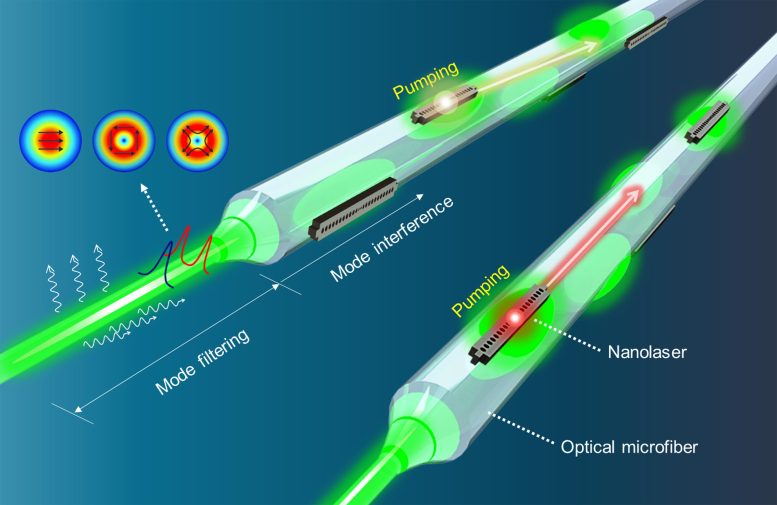New all-optical pumping chip-based nanolaser technology could aid in meeting the ever-growing need to move more data faster.
A new all-optical approach for driving multiple highly dense nanolaser arrays has been developed by researchers in Korea. The method could enable chip-based optical communication links that process and move data much faster than current electronic-based devices.
“The development of optical interconnects equipped with high-density nanolasers would improve information processing in the data centers that move information across the internet,” said research team leader Myung-Ki Kim from Korea University. “This could allow streaming of ultra-high-definition movies, enable larger-scale interactive online encounters and games, accelerate the expansion of the Internet of Things and provide the fast connectivity needed for big data analytics.”
In a paper published today (December 15) in Optica, Optica Publishing Group’s journal for high-impact research, the researchers demonstrate that densely integrated nanolaser arrays — in which the lasers are just 18 microns apart — can be fully driven and programmed with light from a single optical fiber.
“Optical devices integrated onto a chip are a promising alternative to electronic integrated devices, which are struggling to keep up with today’s data processing demands,” said Kim. “By eliminating the large and complex electrodes typically used to drive laser arrays, we reduced the overall dimensions of the laser array while also eliminating the heat generation and processing delays that come with electrode-based drivers.”

These simulation images show how the light interference pattern interacts with the nanolaser arrays. (a) Schematic of spatial interference between TE00 and TE01 modes along the microfiber. Here, two photonic crystal nanobeam lasers (PCN1 and PCN2) are attached to the surface of the microfiber in a line. (b) Difference in effective refractive index (Δn) of TE00 and TE01 modes and corresponding half beat length (Lπ), (c) Log |E|2 profile of PCN cavity mode in the xy-plane and SEM image of fabricated InGaAsP PCN laser. (d, e) |E|2 profiles of the pump beam in the xz- and yz-planes, respectively, where the beam propagates from left to right. (f) Absorbed power density profiles along the xy-plane at the vertical center of PCNs. Credit: Myung-Ki Kim, Korea University
Replacing electrodes with light
The new nanolasers could be used in optical integrated circuit systems, which detect, generate, transmit, and process information on a microchip via light. Instead of the fine copper wires used in electronic chips, optical circuits use optical waveguides, which allow much higher bandwidths while generating less heat. However, because the size of optical integrated circuits is quickly reaching into the nanometer regime, there is a need for new ways to drive and control their nano-sized light sources efficiently.
To emit light, lasers need to be supplied with energy in a process called pumping. For nanolaser arrays, this is typically accomplished using a pair of electrodes for each laser within an array, which requires significant on-chip space and energy consumption while also causing processing delays. To overcome this critical limitation, the researchers replaced these electrodes with a unique optical driver that creates programmable patterns of light via interference. This pump light travels through an optical fiber onto which nanolasers are printed.
To demonstrate this approach, the researchers used a high-resolution transfer-printing technique to fabricate multiple photonic crystal nanolasers spaced 18 microns apart. These arrays were applied onto the surface of a 2-micron-diameter optical microfiber. This had to be done in a way that precisely aligned the nanolaser arrays with the interference pattern. The interference pattern could also be modified by adjusting the driving beam’s polarization and pulse width.
Laser driving with a single fiber
The experiments showed that the design allowed multiple nanolaser arrays to be driven using light traveling through a single fiber. The results matched well with numerical calculations and showed that the printed nanolaser arrays could be fully controlled by the pump beam interference patterns.
“Our all-optical laser driving and programming technology can also be applied to chip-based silicon photonics systems, which could play a key role in the development of chip-to-chip or on-chip optical interconnects,” said Kim. “However, it would be necessary to prove how independently the modes of a silicon waveguide can be controlled. If this can be done, it would be a huge leap forward in the advancement of on-chip optical interconnects and optical integrated circuits.”
- Karlston
-

 1
1




Recommended Comments
There are no comments to display.
Join the conversation
You can post now and register later. If you have an account, sign in now to post with your account.
Note: Your post will require moderator approval before it will be visible.